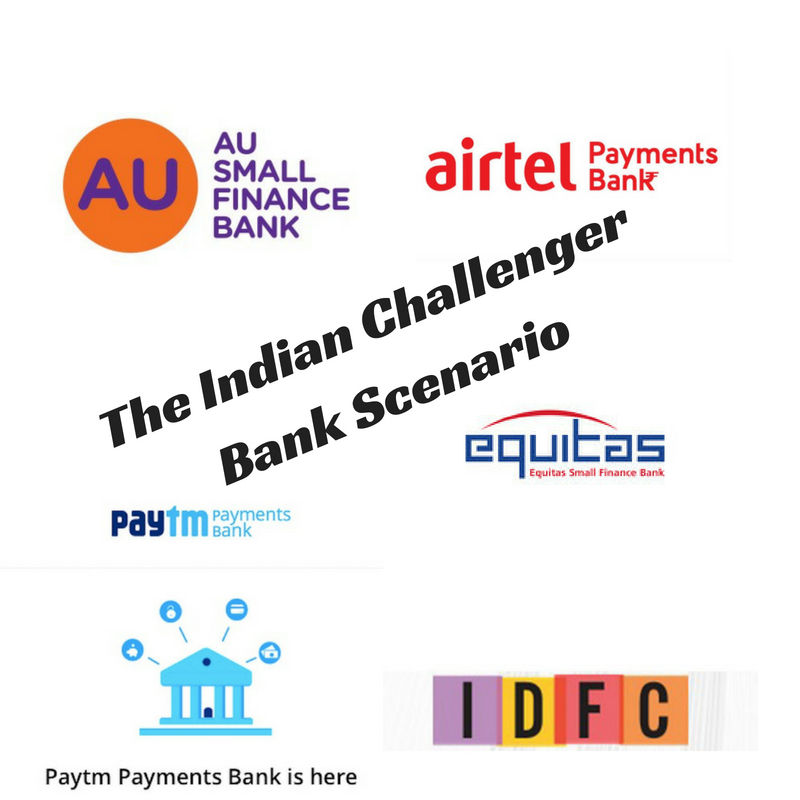The Indian Challenger Bank Scenario
- 13 July 2018 | 2146 Views | By Mint2Save

The term Challenger Banks has been coined to the fintech based revolutionary banks established in the United Kingdom. These banks are not linked to the masters or veterans of the banking sector, but have caught attention due to their high end innovation and customer approach.
Coming to developing economies, India is also heading towards a banking revolution, where financial inclusion holds the key to provide banking services to everyone.
Circa 2013, during the tenure of Raghuram Rajan as the RBI head, he spearheaded the idea of new banking reforms and eased curbs of foreign banking. It was only under him that RBI announced banking licenses for private sector complying with specific norms and after due deliberations, RBI gave nod to two universal banks and eleven payments banks, effectively reforming the banking by introducing new players in the market and strengthening the banking reforms.
However, due to political clashes, Rajan’s second term became a distant dream, and the banking revolution reforms that were the core need of this country was left incomplete.
Coming back to present day 2018, with unfolding of new financial crisis in Banks, the whole banking system seems to be on the verge of collapse and big trusted Bank names for decades seem to be faltering and not adhere to basic guidelines, this is where the newly formed banks who were given licenses by RBI come into play, they would challenge the age-old systems of banking and provide better and more efficient services to every customer around the country while also maintaining the norms and adhering the strict guidelines that every bank would have to follow. This would foster healthy competition amongst banks, as more banks would try to woo customers, they would introduce new schemes and services, better interest rates, customer friendly policies, these would ultimately benefit the customer and the economy as a whole.
Now, RBI with this aim gave permissions to two types of Banks, Universal banks, and Payment Banks, this opened up the question, what are they and what exactly is the difference between these two? Let’s find out:
-
Universal Banks:
Universal Banks are the most common type of Banks, these are the full-fledged commercial banks which can perform any type of banking functions, the concept of universal banks has been picked up from developed countries like UK and US. They can act as a commercial bank providing customer-focused services for the general public, or as investment banks or they can provide a host of wealth management, asset management, financial advisory services as well.
RBI has given license to Bandhan Bank and IDFC Bank to act as Universal Banks.
Setting up of universal banks requires not only a huge amount of capital, but also strong infrastructure. In a developing nation like India, a revolution for financial inclusion is the need of the time, and, universal banks, arguably, were not able to satisfy the same.
-
Payments Bank:
This is a new category of Banks that RBI has conceptualized under the Digital India initiative to give a boost to online payments. Banks applying under “payments banks” license can only accept a restricted deposit of ₹1 lakh per customer. They are only allowed to perform limited functions and focus mainly on the payments side of the business. RBI has given an in-principle nod to 11 companies to form payments bank, these include Paytm, Bharti Airtel, Vodafone m-pesa, Tech Mahindra, Reliance Industries, etc. Payment banks come handy for cashless transactions irrespective of amount of funds involved.
-
Small Finance Banks:
Again a new categorization of Banks introduced by RBI, these are set up specifically to cater to those sections which are not in the interests of big commercial banks, in other words, it focuses on small-scale industries, marginal farms, unorganized sectors. Lately, these small finance Banks have gained a lot of traction and have grown in size.
This is the goal of introducing new banks into the banking domain, now let’s see how these newly formed banking start-ups stack up against decade-old banks, and how they might overcome the big daddy banks to come on the top spot. Let us have a look at some of those banks:
- Bandhan Bank:
Started as a micro-finance company in West Bengal, it grabbed on the opportunity of being a universal bank when RBI announced an application for granting banking licenses. So, it officially became a universal bank in 2014. It started with 501 branches and has now around 893 branches and a team of 27,000 employees, although small in comparison with the other big giants but this bank boasts of strong financials. The RBI Licensing norms specify that any new bank must have a ₹500 crore capital. Indian banking Chanakya, Tamal Bandhopadhyay is on the advisor panel for this bank.
Bandhan Bank began with a huge capital base of ₹2,570 crore and it is now roaring to ₹4,446 crore as on 31st March 2017, this means having a capital to risk-weighted assets ratio or CAR of more 26.34%, which for a new bank is commendable.
The Bank reported a net profit of ₹1345 crores for the year ended 31st March 2018; the profit is already on an increasing trend, which shows the strength in its financials.
- IDFC Bank:
The only bank other than Bandhan Bank to receive an in-principle approval from RBI to be set up as a universal bank. The bank started its operations in October 2015. It formally started out as an NBFC, but it is now a bank known for its innovative ways to reach out to customers. It was the first bank in the country to start Aadhar-based cashless merchant solution.
The bank has reported a profit ₹980 Crores in FY 2018 and has branches in more than 13 states; it is one of the fastest growing banks right now and is poised to be a PAN India bank.
- AU Small Finance Bank:
One of the small finance banks given license by RBI, AU bank is very popular in Rajasthan where it started in Jaipur as an NBFC providing finance for vehicle & trucks, currently AU bank boasts of 284 branches and a profit after tax of ₹301 crores, the Bank has employed more than 8,500 employees throughout the country.
AU Small Finance Bank has garnered investments from all over the world, has made a grand debut in its IPO and is consistently innovating with its products and services.
- Jana Small Finance Bank
What started as NBFC headquartered in Bengaluru is now one of India’s largest micro-finance banks, which boasts of more than 15,000 employees and more than ₹170 Crores in profits. With an aim to open 500 branches by this year, Jana Bank is already present in 18 states and vows to be present in every state and reach the aim of financial inclusion of everyone, which is the core strategy of the bank.
- Equitas Small Finance Bank:
Equitas too started as a microfinance business and in 2015 after receiving in-principle approval from RBI it became a small finance bank. Its IPO of more ₹ 2,175 crores was oversubscribed over 17 times, which reflects the investor attraction towards this young bank, with more than ₹6,500 crores in advances and it has already received permission from RBI to open 412 branches, majority of them in the Southern part of the country.
- Ujjivan Small Finance Bank:
Ujjivan Small finance bank started from 65 branches, and it plans to convert 160 existing branches and 29 unbanked rural centers by the end of this FY, and a workforce of more than 10,000 employees catering to more than 53 lakh customers is a reflection of bank’s sheer size. Its sheer growth and size show its will to outperform against other banks.
- Paytm:
Although technically not a bank, but Paytm was granted a license of a payments bank by RBI, with more than 100 million users and its core strength in payments business, Paytm has been quickly diversifying into various other sector and is already a competitor to these traditional banks in the field of insurance (Yes, Paytm also sells insurance!), Loans and Paytm has recently started Forex & Money exchange services. Why just Paytm is being mentioned here you might think, well Paytm is India’s largest wallet by the number of users and is diversified into so many services like no other, also Paytm is recognized and accepted by everyone small or a big business alike.
There is a good chance that Paytm might come out as a new-age Bank with no physical branches yet with a user growth and financials of a full-fledged bank!
These above-mentioned list of Banks are not exhaustive in Nature but are the names that we will be hearing soon near our doorstep as these Banks today are challenging the very fundamentals of the way we think of Banking.
Let us take the case of Paytm which has no branches yet it has the highest user recognition and usage. The dawn of new-age of banking is approaching and RBI has taken a forward-looking step by introducing new categories of Banks and granting license to private sector companies.
By including the expertise and efficiency of private sector in Banking domain, not only will the economy improve but the backbone of the economy – the banking sector will see a landscape change amidst these scams, this will prevent poor management of funds and improve transparency of these traditional banks, resulting in overall improvement of banking sector, which will at the end benefit the end-user/the citizen of this country!
The response to these new generation banks has been remarkable. Now, banks have started to mirgrate from the conventional brick and mortar structure to small kiosks, mobile vans, and even mobiles. One can now open an account right from the tap of his mobile phone and enjoy fully fledged banking experience.
Not just solutions for deposit or transferring the funds, but even applying for loans has become an easy task now.
Granted that the above-mentioned banks are at a very nascent stage and in no way can be compared to big-daddy banks like SBI but the way they are transforming the current scenario and breaking the traditional methods of banking by introducing new modern ways to bank, they will surely overtake the traditional banks within the next decade.









